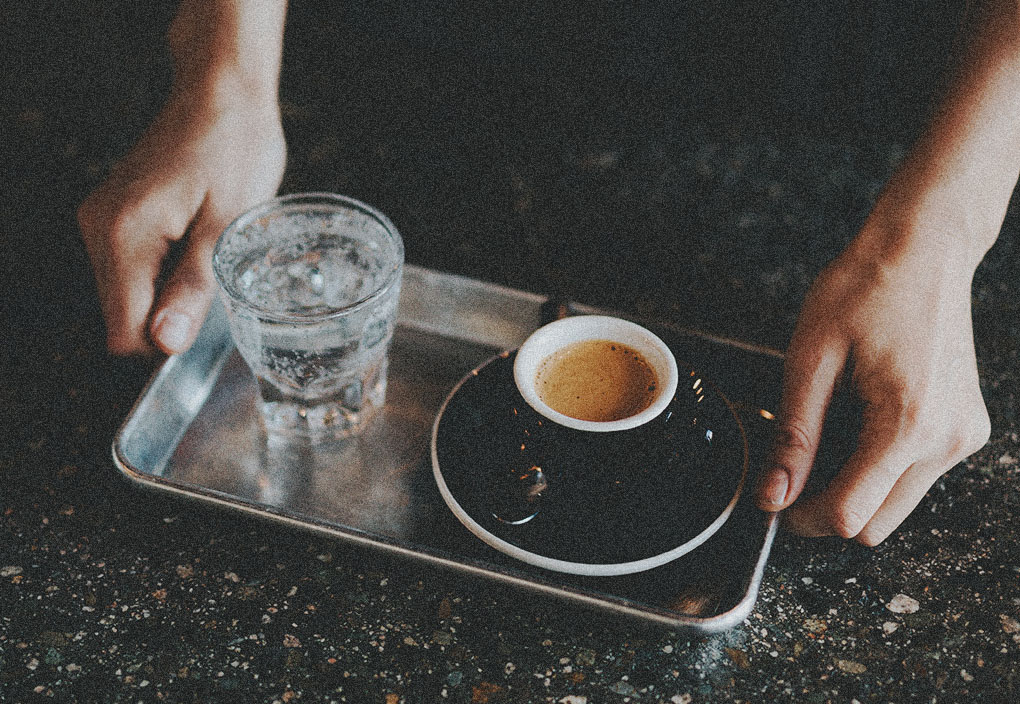Articles
When Tubruk Drinkers Meet Espresso
If first impressions determines 90% of a relationship, espresso perhaps is the most unfairly misunderstood dude around the block.
There is this classic tale of a Tubruk-drinker walking into a café. He saw the menu, which seem very intimidating to him. Full of foreign Italian-sounding terms he never heard of. ‘Asking the barista would seem to make me look like an idiot,’ so he thought. Nobody can know I’m a first timer in here.’ So he controlled his composure, chin-up, order the cheapest kid on the list: our dear espresso. ‘Must’ve been more or less the same with a simple black coffee,’ he mumbled in silence. ‘Damn they do charge 20k for such simple coffee!’.
The coffee arrived in a neat presentation: wooden tray, with two glasses on it: a hotel-juice glass with sparkling water, & a cup sized as big as the letter C you make with your thumb & index finger, containing what seem to be your coffee. The Tubruk drinker almost couldn’t control his face. The barista is looking from across the room. He now looks once more at the cup, the sparkling water, & does the most sensible thing to do: pour the coffee into the water. Behind the bar, the barista gets a heart attack.
Baristas, too, are learning from experience. Wary of customers protesting, baristas now take the initiative to inform the customer, “But, Sir, Ma’am, it’s a very short drink,” assuming that the customer didn’t know. For Indonesian barista & customers alike, espresso is more likely to give us headache rather than relieve it: it’s against everything we know about coffee-drinking.
While we drink Tubruk black coffee to get a caffeine kick, espresso does not necessarily serve us in the same way. Yes, it once was caffeine-kick in Italia. But that’s espresso made from Robusta beans, drank 5 times/day, in a state of hurry. These days, in flourishing third-wave cafes, with espressos made from Arabica, you’ll need to drink DOUBLE the amount to get the same kick. Which might equal to coffee-overdosing in some people’s head.
If not for a caffeine kick, what then, is the point of Arabica espresso? Carefully grown & processed, specialty Arabica comes with promising layers of taste.
You’ll find a lot of jasmine florals in the beginning, going to mandarin orange sweetness.
Coming on towards more vibrant, soft Sunkist orange acidity, with beautiful long finish of bergamot tea. It’s gonna have just the low-medium body, with the silky smooth and slightly juicy mouthfeel.
That, ladies & gentlemen, is a speech from IBC’s champion Yoshua Tanu on his cup of espresso during final round of Indonesia Barista Championship (IBC) 2017. Judging from his trophy, well, it’s hard to say all that flavor is just hullaballoo.
Yes, your cup of espresso could contain all that colourful bits of flower, fruit, sugar, spice, & everything nice. Perhaps you’re more familiar with this unlikely-tastes-of-coffee-which-actually-is-how-coffee-does-taste-like through cups of filter coffee. Closer to Tubruk, but less intense in thickness & flavor. If filter coffee is set of playlist, espresso is that single of an album. Either it’ll make it, or break it.
The magic doesn’t stop at the colourful tasting notes. There is also acidity, bitterness, sweetness, aroma, & aftertaste forming the complexity of an espresso. These subtle signs might be easily missed if you drank in hurry. So, yeah, throw away that mindset of drinking espresso for caffeine kicks. Arabica espresso is more about the joy of slow drinking & intense flavour bursting in your mouth.
Even so, your next espresso wouldn’t be guaranteed to be a delightful experience.
For all the delicacy that espresso offers, it certainly is an art in itself to achieve that level of espresso-crafting. Though made with fancy machines, which could cost as much as a new car, making espresso is slightly more complicated than just press the button & getting automatic result.
No, I’m kidding. It’s much much MUCH more complicated.
Long story short, one second late from turning off the button would give you one bitter cup. One second too early, you’ll get none of the taste complexity. That’s why espresso, both in competition & behind the bar, is the classic pinnacle of barista’s skill. Needless to say, finding a good cup of espresso is one challenging feat.
When you choose to explore the delicacy of espresso drinking, we got some notes to save you lots of heartbreaks. Or rather, to deal with it:
1) An Open-Mind
Don’t think ‘bitter’ in the first place. Yes, it certainly is hard for casual tubruk drinker looking for bitterness in their cup of coffee as their morning kicks. It can very well be as hard for manual brew drinkers looking for casual leisurely experience. In espresso, every bit of sweetness, bitterness, & range of tasting notes will be heightened. These heightened sensations could come as a shock in the first few tries. Some people would notice acidity first. Over the time, you’ll notice layers of sugar & fruits behind this overwhelming acidity. The key is to keep calm & keep tasting.
2) Start with Double Ristretto
Twice as intense, less the volume, double ristretto would introduce your tongue to sensations of ‘body’ & ‘sweetness’, making it all the more familiar to you. While the subtler tasting notes are less apparent in a cup of double ristretto, you’ll find them more easily in a cup of espresso once you get accustomed to sense beyond the ‘body’& ‘sweetness’.
3) Be Prepared for Tremendous Heartbreaks
Exploration of espresso drinking does require you to have a big heart. Not only does it need work from your side, but the barista’s skill contributes a great deal to your experience.
That, Sir, you cannot control.
At current coffee culture, the rate of good espresso you’ll find around the town is unknown. 5 out of 10? 2 out of 10? Who knows. But fret not, the more cups of espresso you taste, the more you know what to look for in a cup of espresso. Perhaps along the way, you’re going to develop certain style of espresso drinking.
So, Tubruk-drinkers, it’s one long journey for your tongue to get used to espressos. Everytime you got “bad” espresso, remember that does not equal to the taste of all espressos in the town. That one shiny cup you’re looking for is out there.
Photo by Nathan Dumlao on Unsplash.

